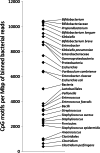Premature neonatal gut microbial community patterns supporting an epithelial TLR-mediated pathway for necrotizing enterocolitis
- PMID: 34362295
- PMCID: PMC8343889
- DOI: 10.1186/s12866-021-02285-0
Premature neonatal gut microbial community patterns supporting an epithelial TLR-mediated pathway for necrotizing enterocolitis
Abstract
Background: Necrotising enterocolitis (NEC) is a devastating bowel disease, primarily affecting premature infants, with a poorly understood aetiology. Prior studies have found associations in different cases with an overabundance of particular elements of the faecal microbiota (in particular Enterobacteriaceae or Clostridium perfringens), but there has been no explanation for the different results found in different cohorts. Immunological studies have indicated that stimulation of the TLR4 receptor is involved in development of NEC, with TLR4 signalling being antagonised by the activated TLR9 receptor. We speculated that differential stimulation of these two components of the signalling pathway by different microbiota might explain the dichotomous findings of microbiota-centered NEC studies. Here we used shotgun metagenomic sequencing and qPCR to characterise the faecal microbiota community of infants prior to NEC onset and in a set of matched controls. Bayesian regression was used to segregate cases from control samples using both microbial and clinical data.
Results: We found that the infants suffering from NEC fell into two groups based on their microbiota; one with low levels of CpG DNA in bacterial genomes and the other with high abundances of organisms expressing LPS. The identification of these characteristic communities was reproduced using an external metagenomic validation dataset. We propose that these two patterns represent the stimulation of a common pathway at extremes; the LPS-enriched microbiome suggesting overstimulation of TLR4, whilst a microbial community with low levels of CpG DNA suggests reduction of the counterbalance to TLR4 overstimulation.
Conclusions: The identified microbial community patterns support the concept of NEC resulting from TLR-mediated pathways. Identification of these signals suggests characteristics of the gastrointestinal microbial community to be avoided to prevent NEC. Potential pre- or pro-biotic treatments may be designed to optimise TLR signalling.
Keywords: Metagenome; Microbiome; Necrotising enterocolitis; Premature infant; TLR4; TLR9.
© 2021. The Author(s).
Conflict of interest statement
The authors declare that they have no competing interests.
Figures





References
-
- Cotten CM, Taylor S, Stoll B, Goldberg RN, Hansen NI, Sanchez PJ, Ambalavanan N, Benjamin DK., Jr Prolonged duration of initial empirical antibiotic treatment is associated with increased rates of necrotizing enterocolitis and death for extremely low birth weight infants. Pediatrics. 2009;123(1):58–66. doi: 10.1542/peds.2007-3423. - DOI - PMC - PubMed
-
- Warner BB, Deych E, Zhou Y, Hall-Moore C, Weinstock GM, Sodergren E, Shaikh N, Hoffmann JA, Linneman LA, Hamvas A, Khanna G, Rouggly-Nickless LC, Ndao IM, Shands BA, Escobedo M, Sullivan JE, Radmacher PG, Shannon WD, Tarr PI. Gut bacteria dysbiosis and necrotising enterocolitis in very low birthweight infants: a prospective case-control study. Lancet. 2016;387(10031):1928–1936. doi: 10.1016/S0140-6736(16)00081-7. - DOI - PMC - PubMed
Publication types
MeSH terms
Substances
LinkOut - more resources
Full Text Sources
Medical

